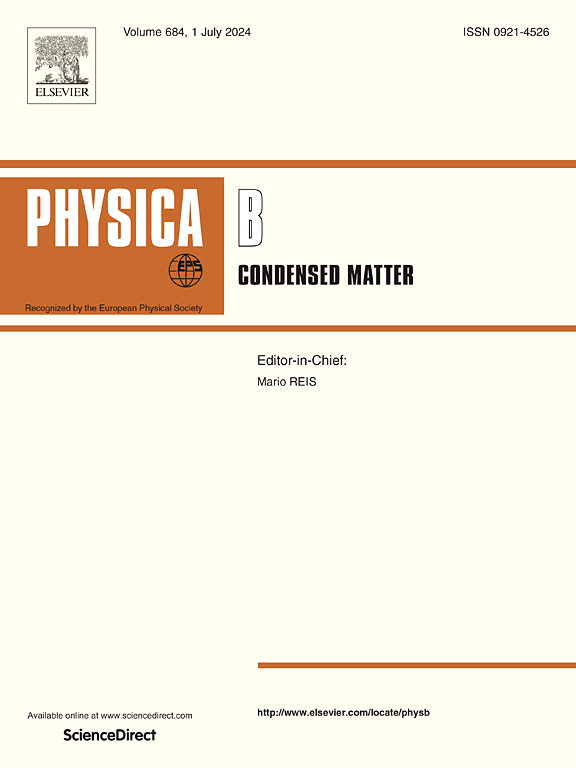First-principles investigation of structural, elastic, anisotropic, dynamic, electronic, thermo-physical, and optical properties of two-dimensional trigonal M2N (M = V, Nb, Ta) compounds for advanced technological applications
IF 2.8
3区 物理与天体物理
Q2 PHYSICS, CONDENSED MATTER
引用次数: 0
Abstract
In this study, the structural, mechanical, elastic, electronic, optical, and thermophysical properties of two-dimensional trigonal M2N (M = V, Nb, Ta) compounds have been investigated using first-principles calculations based on density functional theory. The optimized lattice parameters were found to be a = b = 2.861, 3.142, and 3.085 Å, c = 4.390, 4.412 and 4.840 Å for V2N, Nb2N, and Ta2N, respectively, which are in good agreement with available theoretical data. The formation enthalpies of −1.10 eV/atom (V2N), −0.99 eV/atom (Nb2N), and −0.72 eV/atom (Ta2N) confirm their thermodynamic stability. The elastic constants fulfil the Born stability criteria, and the bulk modulus, shear modulus, and Young's modulus values indicate high mechanical hardness. The B/G ratios (1.76–2.42) suggest that all compounds exhibit ductile behaviour. The electronic band structure confirms the metallic nature of the M2N compounds, with density of states analysis revealing the dominance of transition metal d-states near the Fermi level. The phonon dispersion curves do not contain any negative frequencies, ensuring dynamic stability. Optical properties show a high reflectivity in the ultraviolet region, indicating potential for optoelectronic and coating applications. These results suggest that M2N compounds are promising materials for mechanical, thermal, and electronic device applications.
二维三角形M2N (M = V, Nb, Ta)化合物的结构、弹性、各向异性、动力学、电子、热物理和光学性质的第一性原理研究,用于先进的技术应用
在本研究中,利用基于密度泛函理论的第一性原理计算,研究了二维三角形M2N (M = V, Nb, Ta)化合物的结构、力学、弹性、电子、光学和热物理性质。优化后的V2N、Nb2N和Ta2N晶格参数分别为a = b = 2.861、3.142和3.085 Å, c = 4.390、4.412和4.840 Å,与已有理论数据吻合较好。- 1.10 eV/原子(V2N)、- 0.99 eV/原子(Nb2N)和- 0.72 eV/原子(Ta2N)的生成焓证实了它们的热力学稳定性。弹性常数满足玻恩稳定准则,体模量、剪切模量和杨氏模量值显示出较高的机械硬度。B/G比值(1.76 ~ 2.42)表明所有化合物均表现出延展性。电子能带结构证实了M2N化合物的金属性质,态密度分析揭示了费米能级附近过渡金属d态的优势。声子色散曲线不包含任何负频率,保证了动态稳定性。光学性质显示出在紫外区的高反射率,表明光电和涂层应用的潜力。这些结果表明,M2N化合物在机械、热学和电子器件应用方面是有前途的材料。
本文章由计算机程序翻译,如有差异,请以英文原文为准。
求助全文
约1分钟内获得全文
求助全文
来源期刊

Physica B-condensed Matter
物理-物理:凝聚态物理
CiteScore
4.90
自引率
7.10%
发文量
703
审稿时长
44 days
期刊介绍:
Physica B: Condensed Matter comprises all condensed matter and material physics that involve theoretical, computational and experimental work.
Papers should contain further developments and a proper discussion on the physics of experimental or theoretical results in one of the following areas:
-Magnetism
-Materials physics
-Nanostructures and nanomaterials
-Optics and optical materials
-Quantum materials
-Semiconductors
-Strongly correlated systems
-Superconductivity
-Surfaces and interfaces
 求助内容:
求助内容: 应助结果提醒方式:
应助结果提醒方式:


